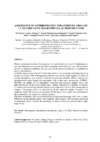Please use this identifier to cite or link to this item:
https://accedacris.ulpgc.es/jspui/handle/10553/121963
| Title: | Assessment of anthropogenic pollution by organic UV filters using macrophytes as bioindicators | Authors: | Cadena Aizaga, Marcia Isabel Montesdeoca Esponda, Sarah Santana del Pino, Ángelo Sosa Ferrera, Zoraida Santana Rodríguez, José Juan |
UNESCO Clasification: | 251002 Oceanografía química 240119 Zoología marina 220922 Radiación ultravioleta 330811 Control de la contaminación del agua |
Keywords: | Anthropogenic contamination Macrophytes Organic UV filters Microwave assisted extraction |
Issue Date: | 2023 | Publisher: | Servicio de Publicaciones y Difusión Científica de la Universidad de Las Palmas de Gran Canaria (ULPGC) | Conference: | VIII International Symposium on Marine Sciences (ISMS 2022) | Abstract: | Marine environment pollution has increased in recent decades as a result of anthropogenic activities. Macrophytes can assimilate the compounds dissolved in the water and respond to changes in surround conditions, for that, they can be used as bioindicators of pollution in aquatic environments. Currently organic ultraviolet (UV) filters have shown ever-increasing in pollution levels in marine ecosystems. The anthropogenic pollution produced by eight organic UV filters in coastal macrophytes was studied. A microwave-assisted extraction (MAE), followed by ultrahigh-performance liquid chromatography with tandem mass spectrometry (UHPLCMS/ MS) was applied to 76 macrophyte (seaweeds and seagrass) samples from three different beaches on the Gran Canaria Island (Spain), collected for 6 months. All studied UV filters were found with different detection frequencies from 16% to 100% in macrophyte samples. Octocrylene (OC) was detected in all the analysed samples throughout the sampling period. The highest concentration (19,369 ng·g-1 dry weight, dw) correspond to this compound in the seagrass Cymodocea nodosa. The bioconcentration ratio was determined for several seaweed groups (red, brown, green). Different bioconcentration grades were obtained. Those above 1,000 indicated significant accumulation, which increases the possibility of chronic effects on seaweed and at upper tropic levels. | URI: | https://accedacris.ulpgc.es/handle/10553/121963 | ISBN: | 978-84-9042-477-3 | Source: | Abstracts Volume VIII International Symposium on Marine Sciences, July 2022 / coordinación, María Esther Torres Padrón, p. 100 |
| Appears in Collections: | Ponencias |
Items in accedaCRIS are protected by copyright, with all rights reserved, unless otherwise indicated.
